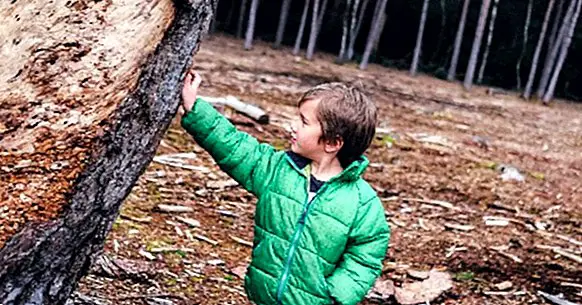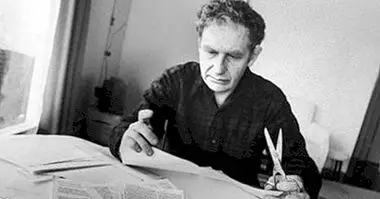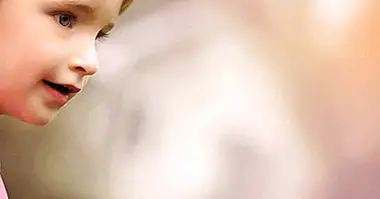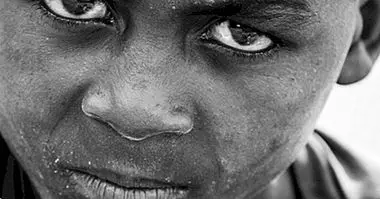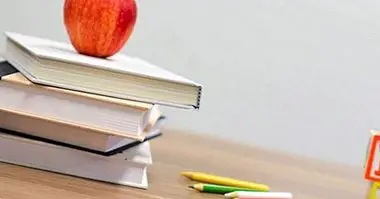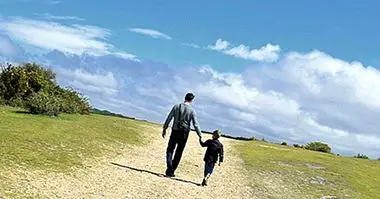14 relaxation exercises for children (step by step)
The childhood is the initial stage and one of the most important of the development, marking to a large extent the way of seeing and experiencing the world of the human being. Beginning with birth and ending in adolescence, at this stage the new being begins to be linked with the world, a world full of new sensations, emotions and things to discover .
But this does not mean that it is an easy stage. In fact in this period there are a lot of things that we are not able to understand and that frustrate us and / or alter our behavior and relationship with the environment. When this happens it is advisable to be able to make children able to relax , which is why in this article we are going to propose eleven relaxation exercises for children.
- Related article: "6 easy relaxation techniques to combat stress"
Children also need to relax
In a society like ours, being able to relax is something necessary to preserve our well-being. The family, the couple, work, friends ... we have many variables to take into account in our lives, something that can easily surpass us if we are not able to relativize things, prioritize them and reduce the level of tension that they produce.
Childhood is a vital stage characterized by a high level of energy and emotion to discover . But while it may seem that the responsibilities that most children have are not too stressful, the fact is that the misunderstanding of how the world works and the presence of some stressors (family, school and group of equals) and frustrated desires can upset them to a large extent and make them suffer. They must be able to manage their sensations, a management that does not come biologically printed but must be learned. Within this management would enter the ability to relax.
The practice from childhood of relaxation techniques not only serves to cope with a situation of concrete stress, but also it helps the child adopt a more centered and realistic position in the world through meditation and relativization of problems . It helps that in the future they are more capable of facing different situations and that they are able to visualize things from different points of view. In addition, it also favors introspection, self-control and physical and mental self-awareness as they become more aware of their own reactions to the world and the circumstances.
Activities and relaxation exercises for children
Given the importance for children of learning to relax and manage stress and frustration, it is important to teach them some techniques to reduce their tension.
Some activities that can facilitate this are the following . Of course, we must bear in mind that some of them can only be applied at certain ages, since they may require a more or less advanced level of intellectual development.
1. Breathing techniques
Some of the easiest and most common relaxation techniques for children and adults are based solely on breathing . It is useful to make them feel comfortable and in silence or with soft music, breathe deeply through the nose and exhale little by little through the mouth. The boy or girl can put one hand on his chest and another on his stomach, to see which of the two moves. In smaller ones it may be useful to use analogies, such as imagining that it is an accordion or a balloon.
2. Jacobson's progressive relaxation
This technique is used in subjects of all ages , both in clinical practice and outside of it, to reduce the level of stress and tension. It is based on the tension and relaxation of different muscle groups while controlling breathing. They begin at the most distal ends of the body (first feet and legs, then hands and arms) to gradually progress towards the center (abdomen, torso) and then towards the head.
In each group of muscles they will be asked to tense for a few seconds and then relax them for three times as long as they have been tensed, doing this process up to three times in a row with each muscle group.
This technique should not be used before seven years of age , since in addition to requiring concentration and voluntary control of breathing can be complex to understand and carried out by a child of lower evolutionary level.
3. Relaxation of Koeppen
Similar to Jacobson's relaxation, this methodology is used for make relaxation exercises for younger children more enjoyable, understandable and enjoyable by making it a game . In this case a more symbolic and ludic method is used, through the imagination of various situations in which they will need to tense and relax different parts of the body.
To relax their hands they are asked to act as if they had to squeeze an orange or lemon, for the arms and feet they make as if they were sinking in the mud, for the shoulders that protect themselves as a turtle would, for the arms that they stretch like a cat, for the jaw they think they are chewing gum, for the face they try to scare a fly without using anything but the face and for the abdomen that they tense to avoid being crushed by an elephant or that they do if they had to go through a very narrow space.
4. On my secure site: Guided imagery
This technique is very useful to reduce tension and anxiety, especially in children with a high level of imagination . It is about creating in the child's imagination a safe and relaxing environment where the reason for the anxiety can not affect them. For example, a wooden house in the mountains, a jungle full of animals or a beach.
This process of imagination is going to be guided by the therapist, teacher or parent in order to provide an environment with elements that are pleasant and reassuring to the child. Relaxation can be reinforced with soft music and a calm and deep tone of voice.
5. Sing
When we think about calming a child, one of the typical images that come to mind is a mother or father singing to his son while he cradles him. Music is a very important element for the human being, that throughout our life cycle can accompany our emotional state and even alleviate our discomfort.
Sing them or make them sing together a simple song, short, that you like and know well and that requires a slight effort to control the tone and rhythm will help to improve the state of tension and relax the infant .
6. We are puppets
A relaxation exercise in the form of a game that children of all ages can enjoy . It is based on being told that they are puppets that are being controlled by a puppeteer, having a string on each end, on the back, and on the head. They will go saying that the puppeteer is pulling the different strings in order to make different gestures and actions.
However after a while they are told that the puppeteer in question is clumsy and occasionally drops one of the strings, which must leave the corresponding body part completely dead for a few seconds. This second part is maintained for several minutes. The game ends by saying that the puppeteer drops all the strings at the same time and / or leaves the puppets, having to de-stress the whole body.
7. The snowman / ice cube
This relaxation exercise for children is based on moving from a state of tension to one of muscular relaxation , in a symbolic and playful way. It is proposed to the children who are snowmen or ice cubes, totally frozen during the winter.
In this initial state they should tighten as much as the muscles can and be immobile and shrunken. However, spring is coming and with the sun, which will melt little by little. With this, progressively the child has to relax the muscles, stretching and loosening.
8. Resist laughter
It is something that we probably all have done on occasion. It is based on asking the child to look at another person while remaining at all times still and keep their composure trying not to laugh , while the other person should do everything possible to make him laugh. It serves from trying to hold the look, make jokes and even tickle.
Both for those who try to resist laughter and for those who try to make people laugh, this relaxation exercise will allow them to focus on the other or on the situation itself.
9. Massage
A hug, a caress ... although it does not happen in all situations or for all people, physical contact with another person tends to be a reassuring element for the human being .
One way to use this fact in relaxation is to perform massages. In addition to the muscle relaxation itself this activity contributes to improve the relationship between those involved, with what is recommended to be used in the school context to improve the relationship between peers or between siblings.
10. Symbolic drawing
Although it may seem obvious to express emotions in any way, whatever type they may be, it helps to release frustration and anxiety. One way to do it is through art. Ask them to draw a picture of what they want will let their imagination flow while concentrating on the completion of the work, which allows redirect the attention and reduce the level of stress. A type of very relaxing drawing that is usually used in these cases is the realization of a mandala, a circular representation of oriental origin in whose elaboration different facets of life, thought and emotions of each person are represented.
Besides to relax them, contemplating the type of drawings and their characteristics allows us to obtain clues of needs, desires, fears and experiences that either the child is not able to explain or does not dare to do so.
11. Karunesh or heart dance
Dance is an art form that allows the expression of feelings and emotions , releasing blocks and repressed elements inside us. While most dances are really useful for releasing energy and relaxing, some types of dance can also serve as a method of meditation.
An example of this is the dance of the heart or Karunesh, based on Yoga and Eastern philosophy. Due to its simplicity and because it allows us to connect with our body, thought and our emotions, it is frequently used as a mindfulness technique. It is based on dancing by controlling the breath and focusing on the beating of the heart while visualizing one's own emotions.
After being placed in a comfortable position, place both hands on the heart and proceed to focus on your heartbeat, seeing each inhalation as the arrival of positive energy and each exhalation as the release of tension. The dance begins by stretching forward the right arm and leg while we exhale, with the palm of the hand out to symbolize the expulsion of discomfort. When inhaling, the limbs are returned to their initial position. Repeats twice with both arms
Later the same exercise is performed, but this time to both sides , and finally a third couple of times backwards. At all times the axis of the body remains in the same place, only varying the position of legs and hands. After a few repetitions the exercise is finished by sitting down and focusing a few minutes only on normal breathing.
12. Hug the stuffed animal
This relaxation exercise is indicated for girls and boys up to 7 years of age. It consists of using a stuffed animal and giving instructions so that the child embraces it increasing and decreasing the force little by little, gradually, in a rhythmic way with the breathing. In this way the muscles tense and relax without getting to make much effort at any time, so that there is a feeling of relaxation.
13. The chameleon
In this exercise, the boy or girl plays to imitate the movements of the chameleon. In this way, the child lies down on the ground and must reach an object located two or three meters away, moving towards it crawling very slowly.
14. Textures
For this exercise you need to use a large cork board and nail a circuit of different textures that form a path. With this material, the boy or girl follows this circuit slowly with his hand until he reaches the final point. You can use cord, different fabrics, soft plastic pieces, etc.
Bibliographic references:
- Amutio, A. (2002) Stress management strategies: the role of relaxation. C. Med. Psicosom, No. 62/63.
- Dris, M. (2010). Relaxation activities in Pre-school and Primary Education. Innovation and educational experiences, 34.
- Echeverría, S. (1998). The children's voice: Education and reeducation. Editorial CEPE.

